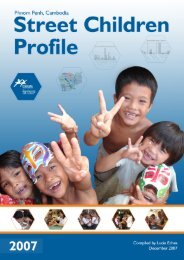Download - Friends International
Download - Friends International
Download - Friends International
You also want an ePaper? Increase the reach of your titles
YUMPU automatically turns print PDFs into web optimized ePapers that Google loves.
to survive on less than 1 dollar a day. Around half of these people live in extreme<br />
poverty, a tendency which is especially pervasive in the rural areas of Cambodia. Amid<br />
the global financial crisis, the Asian Development Bank estimated that an additional<br />
2 million people in Cambodia may have been thrust into poverty as the cost of food,<br />
fuel and other commodities have risen 17 . Consequently, an increasing number of<br />
Cambodian women and children have been seeking work in the informal sector in order<br />
to survive - for lower wages, poorer conditions, and greater risk of sexual exploitation<br />
and trafficking.<br />
Street Life of Cambodian Children/Youth<br />
The majority of street children/youth in Cambodia, like in most countries, live in the<br />
capital and big cities as they are<br />
considered to have better economic and<br />
employment opportunities by migrants<br />
from the provinces 18 . The reality is that<br />
they usually live in appalling conditions<br />
with no protection and often no record<br />
of their existence. While the street<br />
children/youth phenomenon generally<br />
is seen as urban, there is an increasing<br />
tendency in the rural areas in Cambodia. The impact of street life on children/youth in<br />
Cambodia is considerable. Unstable lifestyles, lack of medical care and inadequate<br />
living conditions increase young people’s susceptibility to exploitation, substance abuse,<br />
chronic illness, sexual violence and sexually transmitted diseases 19 .<br />
Based on the 2008 snapshot survey 5,622 street children/youth were counted in six<br />
Cambodian locations, however, based on rough estimations of the CSCN members,<br />
these figures could be up to four times higher 20 . Responding to the magnitude of<br />
the street children/youth problem and underprivileged children in general, a growing<br />
number of institutions and orphanages have been set up by both NGOs and government<br />
agencies – arguing that institutionalising street children/youth is for their own good.<br />
However, replacing children and removing them from families or family networks is not<br />
CSCN<br />
18 CSCN Street Children Profile 2009






